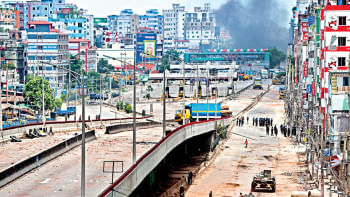Pride in Bengal's Blue
Recently named one of the 'Cool Crusaders of Conscious Clothing' by Vogue India, Living Blue is one of the frontlining revivalists of indigo as a natural dye in Bangladesh. Besides cultivation, it focuses on producing a range of unique products involving quilting and hand embroidery.
Mishael Aziz Ahmad, Manager of Living Blue, explained how the organisation began its journey. In its earliest stages, "Living Blue came to exist as experts travelling around Rangpur and other northern regions of Bangladesh accidentally discovered and identified the indigo plant's existence," Ahmad recalled. Soon enough, indigo became the flagship product of Living Blue.
Indigo is a legume and a nitrogen fixer which enriches the soil, Ahamad said, adding, "While the leaves are used for the dye, the stem can be used for firewood as well." Moreover, it is a native crop of choice as a buffer crop that made its return as a dye through Living Blue. They work with landless farmers as well, providing them with seed and land leased from the local government, boosting incomes during the lull agricultural period. Living Blue also buys leaves from small individual farmers.
Extraction and cultivation of indigo in Bengal was marred by a history of cruel exploitation, but the present is starkly contrasting. Farmers, if they choose to get involved, are provided seeds by Living Blue. Hence, farmers and indigo processors become both willing partners of the organisation. Moreover, Ahmad emphasised that indigo is only a buffer crop now, so it does not clash with the farming of food crops and there is no strenuous labour involved either.
Moving on future plans, Ahmad said that Living Blue would like to expand the usage of the dye locally and internationally. "Bangladesh produces perhaps the finest indigo in the world, and Living Blue is proud to be the major producer of it," Ahmad affirmed with pride. They are aiming to increase production to meet with rising global demands and at the same time, they want to exert a positive impact on the lives of the farmers, artisans and dyers involved.

 For all latest news, follow The Daily Star's Google News channel.
For all latest news, follow The Daily Star's Google News channel. 



Comments